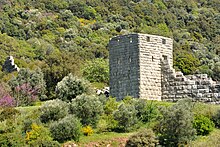Archaia Messene is located 25 kilometres (16 miles) north of Kalamata and 60 kilometres (37 miles) east of Pylos.
History
The main ancient source on Messene is the Guide to Greece of Pausanias, who visited there between 155 and 160 AD.Excavation of the site began in 1828 in connection with the French Morea Expedition during the Greek War of Independence. The French left in 1833; meanwhile, only exploratory excavation had been performed. The current excavator, Petros Themelis, who received permission to dig from the Council of Athens Archaeological Society in 1986, suggests that systematic excavation of the site was first undertaken by George Oikoumenos of the Athens Archaeological Society in 1895. Since then a number of noted archaeologists have made contributions, not the least the current excavator.[4] A museum of their extensive finds has been constructed within the old city walls.
This site was awarded a European Union Prize for Cultural Heritage / Europa Nostra Award in 2011.[5][6]
Bronze Age Messana
During the Bronze Age the palace at Pylos controlled Messenia politically and economically. A Linear B tablet from there, PY Cn 3, mentions a region called Mezana in local Mycenaean Greek (Linear B: 𐀕𐀼𐀙, me-za-na), from which groups of men named from places in the Peloponnesus each contributed one ox (Linear B: 𐀦𐀃, qo-o; also denoted by the BOS ideogram, i.e. 𐀘) to an official, possibly a priest in the Zeus-sanctuary, named *Diwijeus (Linear B: 𐀇𐀹𐀋𐀸, di-wi-je-we DAT; the word could be, instead of an anthroponym, an adjective meaning "priest in the Zeus-sanctuary").[7] These groups were members of the coast-watchers, a military or quasi-military unit that presumably were stationed to guard various locations on the coast. Their failure is attested by the burning of Pylos a few months later by assailants unknown from the sea. The watchers include some Olumpiaioi (Olympians) from Orumanthos (Mt. Erymanthos). John Bennet expressed the opinion that by Mezana is meant Messana, a Mycenaean Greek form of Messene. He supposed that the region around Ithome would already have had that name, to be reutilized by Epaminondas a thousand years later.[8]Messene restored by the Thebans
Reconstitution of the city
The ancient Stadion.
After all due care to obtain omens from the gods, make sacrifices and invite the spirits of past rulers and heroes to live in Messene, including Queen Messene, Epaminondas invited construction engineers and artisans from anywhere to join him. In 85 days the combined armies and exiles guided by the engineers and artisans had complete the walled city of Messene over the site of the previous Ithome. The city included within its walls Mt. Ithome and enough agricultural land and spring captures to withstand a siege indefinitely. The policy was justified almost immediately. After the departure of the Theban army the Spartans attempted to retake Messenia, which then allied itself with the Macedonians. This time the long struggle with Sparta was brought to a final end by the Macedonian conquest of Greece.
After the departure of the allies the new city and the fate of Messenian independence were left in the hands of the Messenian exiles, who had returned primarily from Sicily and North Africa. Apparently they had maintained a transitory community in exile, or diaspora, for some 300 years. They spoke a Doric dialect. Pausanias reports, "even to this day they preserve it in its purity better than anywhere else in the Peloponnese."[11] As the Arcadians are known to have spoken a dialect closely related to Mycenaean Greek, the exiles restored were not from the original Achaean refugees of the return of the Heracleidae, but were the Doricised population that developed in the 7th century BC under the subsequently dispossessed Heraclid dynasty of Messene.
Fortified wall
A watchtower in the circuit wall
Public buildings and monuments
View of the Odeon.
The other buildings which can be identified are the theatre, the stadium, the council chamber or Bouleuterion, and the propylaeum of the market, while on the shoulder of the mountain are the foundations of a small temple, probably that of Artemis Laphria.
Source:
wikipedia





Δεν υπάρχουν σχόλια :
Δημοσίευση σχολίου